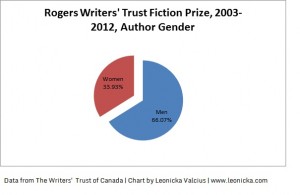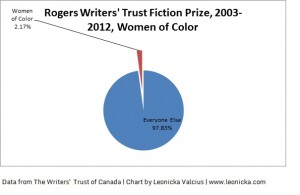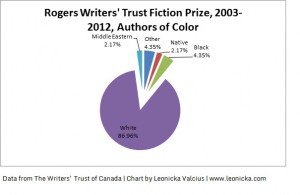CanLit made headlines last week because of sexist and racist comments by Canadian novelist David Gilmour. The drama began with his interview in Hazlitt magazine where he said he didn’t teach books by women, only “serious heterosexual guys,” then continued in the National Post where he made a bad situation worse.
The Canadian publishing industry was outraged. By the end of the day the story had gone viral and was picked up by American sites such as Salon, and Jezebel.
It’s almost funny what a farce the whole thing is.
I am not excusing David Gilmour’s comments or views. He absolutely deserves the backlash. But for Canadian literati to pretend David Gilmour is not a product of an industry that is centered on exclusion and elitism is laughable. David Gilmour is not the only one who favors books by white middle-aged authors.
Last week I posted the results of my analysis of diversity in the TD Canadian Children’s Literature Award. They were discouraging. In anticipation of the Rogers Writers’ Trust Fiction Prize announcement, I decided to look at how diverse their nominees have been in the past 10 years. The results show more of the same.
About the Rogers Writers’ Trust Fiction Prize and my methods
Created in 1997, “the Rogers Writers’ Trust Fiction Prize recognizes Canadian writers of exceptional talent for the year’s best novel or short-story collection. The winner, selected by a three-member, independent judging panel is announced at the Writers’ Trust Awards event.” For more information: http://www.writerstrust.com/Awards/Rogers-Writers–Trust-Fiction-Prize/PrizeHistoryandGuidelines/Prize-Guidelines.aspx Noteworthy points include the $25,000 grand prize and the $2500 awarded to each finalist.
I used the same methods as I used in my analysis of the TD Can. Children’s Lit Awards, as they were simple, relatively quick, and no glaring have come to my attention. I looked at all the nominees for the past ten years (2003-2012) for a total of 50 nominees and 46 unique authors. The raw data I collected is here. The results are below.
Results


Note:
The only woman of color nominated in the past ten years was Esi Edugyan for Half-Blood Blues.

Note:
The “Other” category includes M.G. Vassanji who self-identifies as an African Asian Canadian, and Rabindranath Maharaj who may be most accurately described as Indo-Caribbean.
Down the hall?
With approximately one third of the nominees being women, the Rogers Writers’ Trust Fiction Prize juries can say they are less sexist than David Gilmour. When it comes to race, though, their hypothetical bookshelf is very white. Only six people of color nominated in ten years (none of them Chinese, for what it’s worth).
At least Gilmour offered his students an option. At least he directed them to go “down the hall.” But what is down the hall from some of the highest literary awards in the country? Where do women of color go to get their work honored, publicized, and rewarded? And, because it is foolish to ignore the importance of monetary recompense in a profession that notoriously pays little, where can they go to get a large prize for their excellence?
These are not rhetorical questions. If you know the answer, please share them in the comments or on Twitter using the #DiverseCanLit tag.
If the great Canadian literary awards are not honoring people of color, there must be an alternative Canadian body that is. If no such body currently exist, then the industry as a whole is saying that people of color (especially women of color) do not produce literature that is worthy of praise.
But please, tell me again how outraged you are by David Gilmour.


[…] the Giller is slightly more diverse than the TD Canadian Children’s Literature Award and the Rogers Writers’ Trust Fiction Prize. But that’s not saying much. There seems to be unwritten rule that keeps authors of color at […]